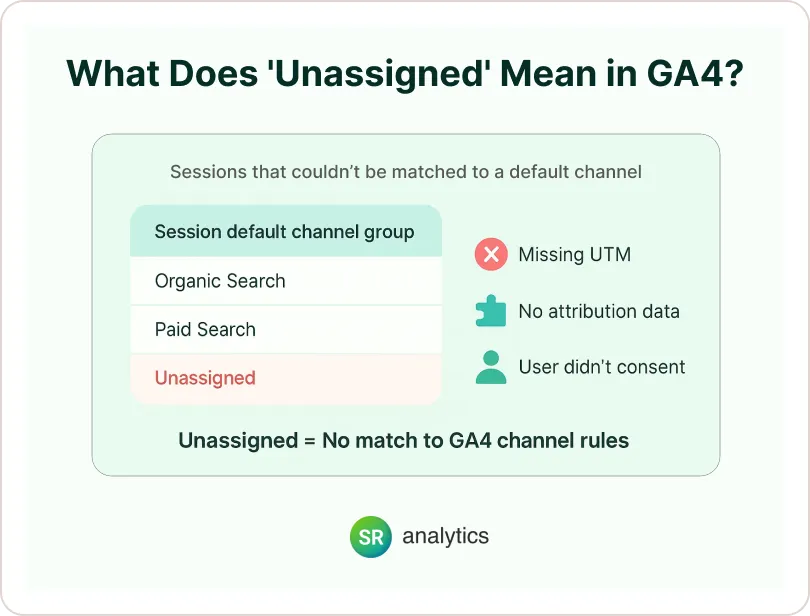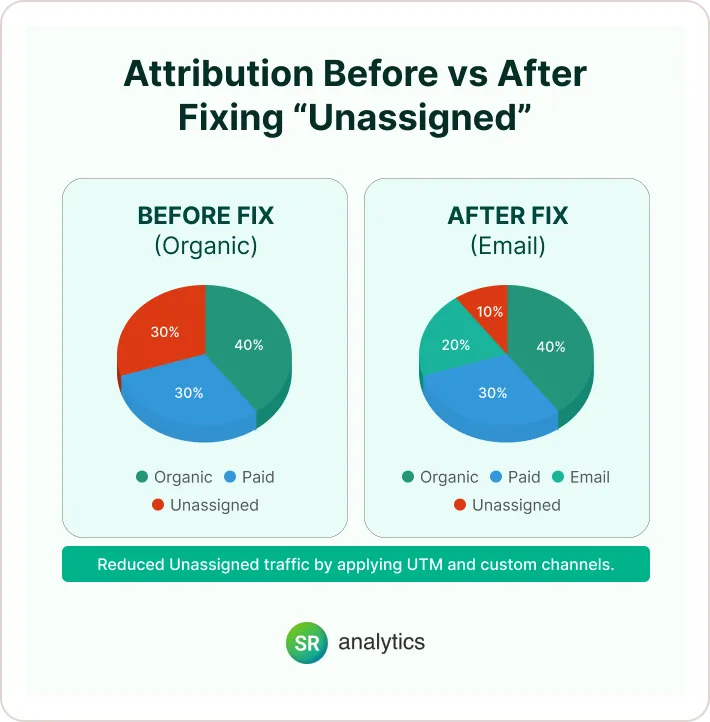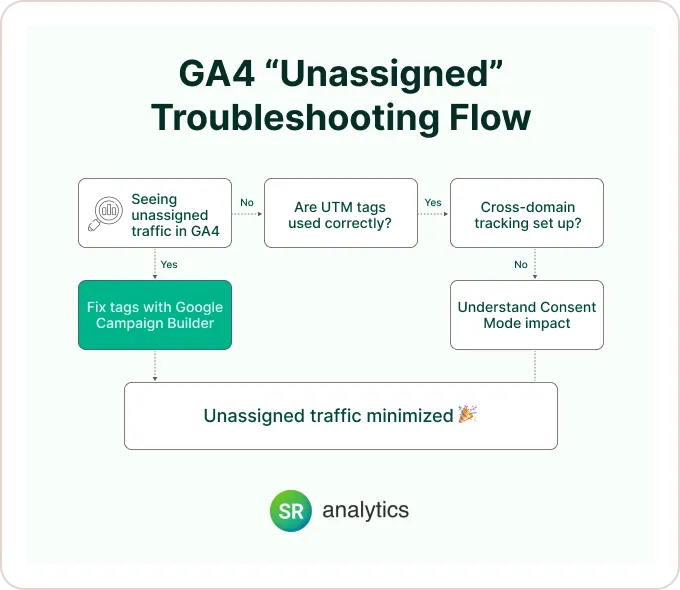Struggling with Unassigned Google Analytics data in your reports? You’re not alone—and we’re here to help you fix it.
“Unassigned” data in GA4 is a common frustration for businesses trying to make sense of where their traffic is coming from.
If you’ve ever opened your Traffic Acquisition report and noticed a big chunk of your sessions falling under “Unassigned,” you’re probably wondering:
What does this even mean? Is something broken? How can I fix it?
This guide answers all those questions and more. We’ll explain:
- What “Unassigned” means in GA4 (and why it shows up)
- The most common causes—some fixable, some inevitable
- How to quickly identify and fix these issues
- Actionable steps to reduce Unassigned traffic in your reports
- Real tools, examples, and a step-by-step troubleshooting plan
Let’s dive in.
What Is “Unassigned” Data in GA4?

In Google Analytics 4, the Session Default Channel Group dimension categorizes traffic into buckets like “Organic Search,” “Direct,” “Paid Social,” and so on. But when GA4 can’t determine the source or medium of a session—or the values don’t match its predefined channel grouping rules—it places that session in the mysterious “Unassigned” category.
According to Google, Unassigned is “the value Analytics uses when there are no other channel rules that match the event data.”
That means:
- The user clicked a link with incorrect or missing UTM parameters
- Tracking scripts weren’t set up properly
- There was a technical issue (e.g., session fragmentation)
- Or… the user simply didn’t consent to being tracked (hello, privacy laws)
What is “Unassigned” in GA4?
“Unassigned” in GA4 means that Google Analytics couldn’t determine the traffic source, typically due to missing or misconfigured UTM parameters, tracking issues, or privacy settings. It’s a catch-all bucket for sessions that don’t meet any default or custom channel definitions.
Quick Fixes for Unassigned Traffic in GA4
Add UTM parameters to all campaign URLs
Use consistentutm_source,utm_medium, andutm_campaigntags on all external links (email, social, ads).Check your GA4 tag configuration
Make sure GA4 is firing correctly across all pages via GTM or gtag. Use GA DebugView to test live traffic.Audit referral exclusions and cross-domain settings
If your own domain or payment gateways are listed incorrectly, sessions can show up as “Unassigned.”Inspect auto-tagging in Google Ads
If Google Ads auto-tagging is off, or destination URLs are modified by redirects, source/medium may not pass through.Review consent management settings
Privacy banners blocking tracking scripts can cause sessions to appear as unassigned due to missing data.
Why Should You Care?
If a large percentage of your traffic is labeled Unassigned, it’s essentially invisible. You won’t know if it’s from paid ads, email campaigns, social posts, or direct visits. This impacts your ability to:
- Attribute marketing efforts accurately
- Allocate budgets wisely
- Understand user behavior and journey
- Optimize conversions
This makes Google Analytics 4 attribution unreliable if left unaddressed.
That’s why identifying and fixing Unassigned traffic should be a priority for anyone who manages or reports on GA4 data.
Research Summary: What We Learned from the Top 10 Industry Blogs
After analyzing 10 top-ranking blogs on the topic—including posts from Analytics Mania, Search Engine Land, OptimizeSmart, and NoGood—we found:
Common Causes of Unassigned Traffic:

- Missing or non-standard UTM tags
Using utm_medium=newsletter instead of email can cause GA4 to miscategorize the traffic. - Misconfigured Google Tags or GTM
GA4 config tag not firing first or duplicate tags creating confusion. - Cross-domain tracking issues
Users moving between domains (e.g., shop.example.com to example.com) without proper setup will start a new session. - User privacy/consent restrictions
Users who decline cookies won’t be tracked with attribution data—leading to Unassigned. - Technical gaps
Ad blockers, short session timeouts, bot traffic, server-side misconfigurations. - Data processing delays
Viewing traffic from the last 24–48 hours can falsely inflate Unassigned numbers due to GA4’s processing lag.
What Competitor Blogs Do Well:
- Analytics Mania and OptimizeSmart provide comprehensive technical breakdowns, including advanced causes like Measurement Protocol and consent mode.
- NoGood and Napkyn focus on actionable quick fixes with simple explanations.
- Megan V. Walker uniquely focuses on a reporting workaround using GA4’s Custom Channel Grouping.
What They Miss:
- Lack of prioritization—some posts list dozens of issues without saying which to fix first.
- Not enough emphasis on privacy regulations and Consent Mode’s role in Unassigned data.
- Few visuals or step-by-step diagnostics to help non-technical users troubleshoot effectively.
- Minimal use of real-world examples to illustrate improvements after implementing fixes.
How to Identify and Fix “Unassigned” Traffic in GA4

Before diving into solutions, it’s critical to diagnose what’s actually causing the Unassigned traffic on your site.
Step 1: Pinpoint the Source
- Go to Reports > Acquisition > Traffic Acquisition
- Find the row labeled “Unassigned”
- Add a secondary dimension: Session source/medium
- Look for patterns (e.g., (not set)/(not set), Facebook referrals, internal links)
Pro Tip: Avoid reviewing data from the last 48 hours. GA4 often takes time to properly categorize recent sessions.
Step 2: Quick Fixes for Common Causes
Here are the most common problems—and how to fix them fast:
Fix 1: Standardize Your UTM Tags
Problem: Custom or incomplete UTMs don’t match GA4’s channel rules
Fix:
- Always include utm_source, utm_medium, and utm_campaign in your URLs
- Use standard values:
- utm_medium=email (not newsletter)
- utm_medium=social (not Facebook or fb_post)
- Use Google’s Campaign URL Builder
Example:
Bad: https://example.com/?utm_medium=newsletter
Good: https://example.com/?utm_source=newsletter&utm_medium=email&utm_campaign=may_campaign
Fix 2: Ensure GA4 Tag Fires First
Problem: Other tags or events fire before GA4 config tag
Fix:
- In GTM, use the Initialization trigger for your GA4 Config tag
- Use Tag Assistant to confirm GA4 is loading only once
- Check for duplicate tags from plugins, templates, or old scripts
Fix 3: Implement Cross-Domain Tracking
Problem: Sessions break when users move between domains
Fix:
- In GA4: Admin > Data Streams > Configure Tag Settings > Configure Your Domains
- Or in GTM: Enable allowLinker and add domains in GA4 config tag
- Prevent self-referrals by listing internal domains
Fix 4: Use Referral Exclusion Lists
Problem: Internal or partner domains incorrectly counted as referrers
Fix:
- Admin > Data Streams > Configure Tag Settings > List unwanted referrals
- Add domains like payment.example.com, checkout.stripe.com, etc.
Fix 5: Monitor Consent & Privacy Settings
Problem: Users declining cookies won’t have tracking data
Fix:
- Implement Google Consent Mode to model conversions
- Clearly explain tracking benefits in your cookie banner
- Accept that some Unassigned traffic is inevitable due to privacy regulations
Fix 6: Reclassify Unassigned Traffic with Custom Channels
Problem: Some Unassigned sources are known but non-standard
Fix:
- Create Custom Channel Groups
- Admin > Data Settings > Channel Groups
- Create new rules like: source = newsletter.mybrand.com → Email
- Reap immediate reporting benefits without waiting for UTM changes
Fix 7: Prevent Bot Traffic
Problem: Bots often have no attribution info
Fix:
- Enable GA4’s default bot filtering (on by default)
- Exclude known spam referrers in your reporting filters
- Consider server-side tracking for high-risk sites
Bonus: Troubleshooting Flow (Prioritized)

- Start with UTM tags – fastest fix, most common cause
- Check GA4 tag setup – config tag must fire first
- Audit recent campaigns – emails or ads with missing UTMs
- Review cross-domain settings
- Consider user consent and privacy tools
- Use custom channel grouping to clean up reports
- Log issues and test fixes using DebugView
Visual Example (Optional for Blog Visual Team)
GA4 Traffic Report (Before Fix):
| Channel Grouping | Sessions |
|---|---|
| Organic Search | 1,450 |
| Unassigned | 620 |
| Paid Search | 400 |
After Fix (Improved Attribution):
| Channel Grouping | Sessions |
|---|---|
| Organic Search | 1,450 |
| 300 | |
| Referral | 200 |
| Paid Search | 400 |
| Unassigned | 120 |
This reflects better clarity on campaign performance and helps improve ROI tracking.
Pro Tools and Resources to Use
Here’s a toolkit to help you resolve Unassigned issues faster:
| Tool | Use |
|---|---|
| GA4 DebugView | See what data is (or isn’t) sent in real-time |
| Google Tag Assistant | Check which tags are firing and in what order |
| Campaign URL Builder | Build standardized UTMs |
| Screaming Frog | Find untagged or untracked pages |
| GA4 Custom Channel Groups | Reclassify Unassigned traffic for better reporting |
| BigQuery (if enabled) | Analyze raw session data for complex troubleshooting |
Final Thoughts: From Frustration to Fix
GA4’s “Unassigned” label isn’t a bug—it’s a signal. It tells you something is missing or misaligned in your tracking setup.
The good news? Most causes are fixable—and often with just a few tweaks to your UTMs, tag configuration, or domain settings.
“And if you’re just getting started with GA4, our GA4 migration and data recovery guide will walk you through setup and optimization.”
That’s why solving GA4 unassigned issues should be a top priority for analysts and marketers.
Other causes (like privacy-related gaps) may not be fixable but are manageable with proper reporting strategies.
Takeaway: Don’t let unassigned data obscure your insights. Fix what you can. Classify what you know. And monitor what’s left.
If you need help auditing your GA4 setup or want expert support implementing best practices, our team at SR Analytics offers dedicated Google Analytics consulting services to help you unlock the full potential of your data.














